JAHEZ'S FINANCIAL ANALYSIS
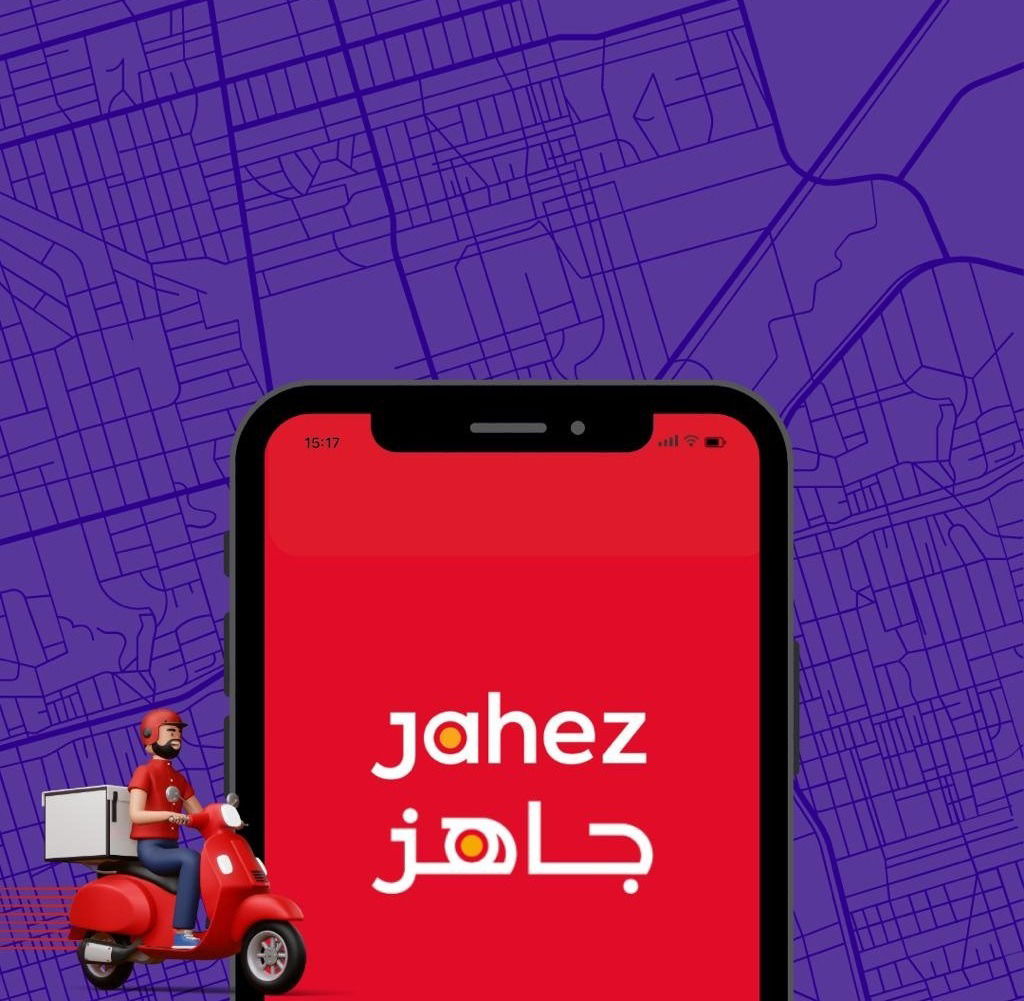
Jahez, is a Saudi Arabia-based food delivery company that operates in a fast-growing industry and the company has several reasons which make it an attractive candidate for financial analysis. Here are a few:
1. Strong revenue growth: Jahez has experienced strong revenue growth in recent years, driven by increasing demand for food delivery services. This growth is expected to continue, as the food delivery market in the Middle East is projected to grow rapidly in the coming years.
2. Expansion into new markets: Jahez has recently expanded its operations to other Gulf Cooperation Council (GCC) countries, presenting potential growth opportunities for the company.
3. Investment and partnerships: Jahez has secured significant investments from reputable investors, including Saudi Arabia's Public Investment Fund, which can indicate a level of financial stability and investor confidence in the company. Additionally, the company has formed partnerships with several major restaurants and food chains, which can help to expand its customer base and revenue streams.
4. Competitive position: Jahez is one of the leading food delivery companies in Saudi Arabia, with a strong market presence and brand recognition. The company has also invested in technology and logistics to improve its delivery services and stand out from its competitors.
Overall, Jahez's strong revenue growth, expansion into new markets, investment and partnerships, and competitive position make it an attractive candidate for financial analysis. However, any financial analysis should consider the risks and challenges that the company may face, such as regulatory changes, competition, and market volatility.
The size of the global food delivery sector:
The size of the global online food delivery market was estimated at USD 221.65 billion in 2022, and it is projected to increase at a CAGR of 10.3% from 2023 to 2030. The proliferation of smartphones, increasing technological innovation, the rise of cloud kitchens, and expanding internet penetration all contribute to the growth.
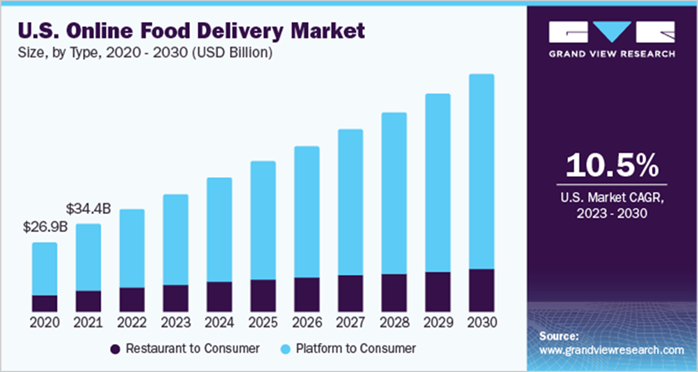
The Food delivery sector in the Kingdom of Saudi Arabia:
In Saudi Arabia, the online food delivery market was estimated to be worth $3.95 billion in 2021. With a value of $4.71 billion in 2022, the online food delivery market is anticipated to grow and reach $8.80 billion by 2028. Between 2022 and 2028, the Saudi Arabia Online Food Delivery Market is estimated to grow at a CAGR of about 10.98%. The key forces behind market expansion are digitization and the development of sophisticated online meal-ordering systems.
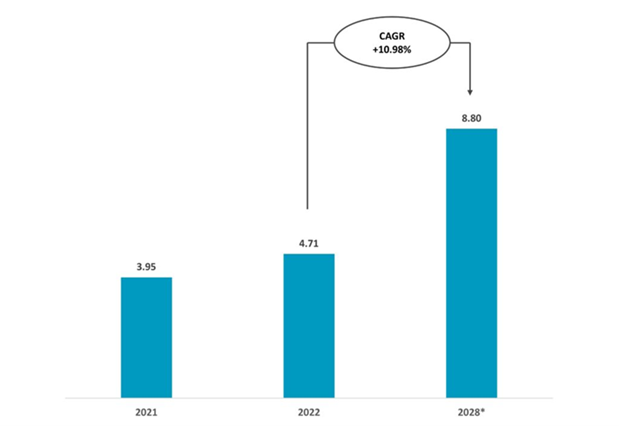
Saudi Arabia Online Food Delivery Market During 2022-2028 ($Billion)
In Saudi Arabia, there is an increasing acquiring of food delivery companies to enhance their positions in the food delivery sector for example, in 2022, the Saudi food delivery platform Jahez signed a contract to acquire Chefz, one of its main competitors in the region to strengthen its position online food delivery market in Saudi Arabia.
And after we looked at the size of the sector globally and locally, we now look at the development of Jahez:
“Jahez” company has gone through many developments over the past years, starting from its launch in 2016 until now, for example, in 2017 it reached one million requests through the “Jahez” platform.
Jahez” is the fastest-growing company in terms of market share in the field of food delivery services in the Kingdom. The group spent the first years working on its technology and its initial spread in the market after launching the “Jahez” platform in 2016. Once the group became satisfied with its unique product offering and its position in Riyadh, it embarked on a rapid expansion program. This was met with impressive success, as the group increased its presence from 22 cities in 2019 AD and now it has expanded to 90 cities throughout Saudi Arabia and has also expanded in Bahrain and Kuwait.
In view of the rapid technical developments, the group seeks to consolidate its position in the digital arena by providing stakeholders with the technical integration they need to obtain fast, smooth, and effective services. The group has developed several technologies that provide reliable, flexible, and automated technology platforms. The "Jahez", Pik and Blue Store platforms depend on main components and are built in the form of micro-services, including:
- Mobile Application for Customers: The Group offers Jahez, Pik, and Blue Store platforms through easy-to-use mobile applications with a simple and easy user interface
- Mobile Application for Delivery Partners: The group provides the Saned application, which is a platform targeting delivery people. In addition, all delivery representatives are authorized by the Communications, Space and Technology Commission, which helps to drive the growth of the delivery system while providing better access to financing and developing systems that encourage innovation.
As a result of continuous technological development, the group is able to innovate and update its services to better keep pace with the expected growth of the sector. These developments reinforce its vision of becoming the most popular platform and support its expansion plans in the delivery sector through electronic platforms and supporting sectors.
In research and development to create knowledge and improve services, the group established the Research and Development Department based on its realization of the importance of research and development to provide the best services and raise standards. This department gives priority to tracking developments in concepts and technologies worldwide and creating new features to contribute to growth in all sectors.
The Research and Development Department worked on improving and developing a number of service areas that helped raise the level of service. It also introduced new features such as the “Logi” dashboard to forecast the level of demand in certain regions, which proved the value of research and development, improved the innovation framework, and strengthened the capabilities of the team and tools.
Also, the focus on development has become more, and this is evidenced by the increase in research and development expenses over the past years:
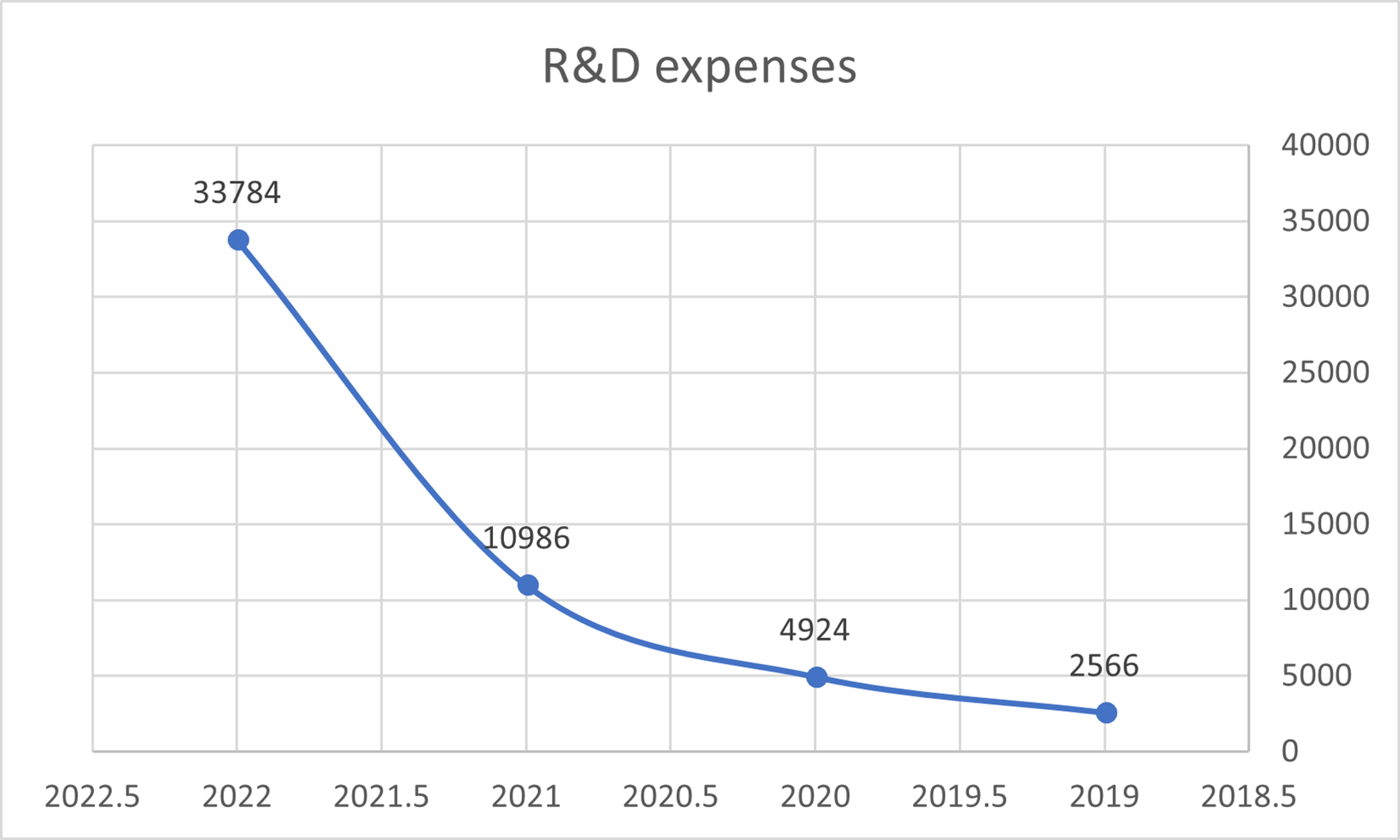
the number of orders has increased due to the developments made, Also, over the past years,
by the company:
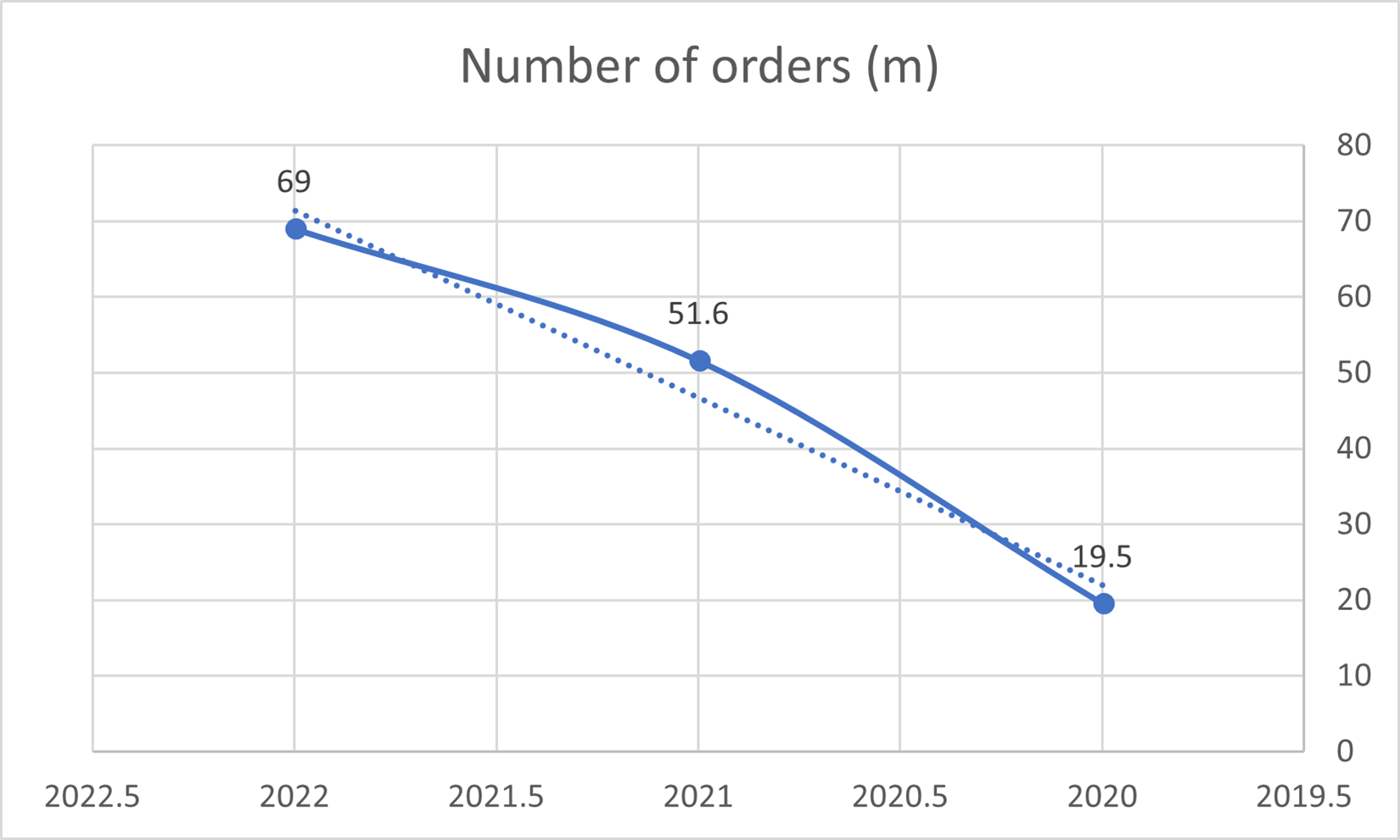
Sector growth
The result of the company's developments and the success it has achieved is a clear indication of the strength of the company's business model, team, and future vision. With the company entering the markets of Bahrain and Kuwait, the company has a future of success at the regional level as well.
The initial public offering of Jahez company, it attracted a large demand from prominent investors at the level of the Kingdom, the region, and the world. It is the first major investment in a Saudi initial public offering. Which in turn encourages financial institutions to participate in future listings in the main and parallel markets that will permanently enhance the investment scene.
the group is expected to benefit from the ongoing government-led economic development and diversification programmes, which aim to stimulate private sector growth and improve the Kingdom's digital infrastructure. When looking at this growth and global market trends, the group occupies a good and exceptional position as the group is among the main companies that are witnessing growth in its markets. The market in the Kingdom is witnessing a strong network effect, like what is witnessed in the global markets, where a small number of companies dominate the food delivery market through applications in the Kingdom. Strong infrastructure and demographics, along with government support and the penetration of smartphones, will be important enablers for future growth.
As we see the company's rapid expansion, the reason behind this is a set of strategic axes that contribute to its future growth.
Enhancing the group's operations in the current geographical areas by acquiring a larger share of the market and attracting new clients and partners.
Expanding business in supporting sectors and entering new geographical areas to achieve future growth.
Differentiate the group's services and offerings through continuous innovation.
By comparing the gross profit between the past years, we can expect the positive future of the company in the continuous expansion of the gross profit.

We note that the average number of branches has increased over recent years.
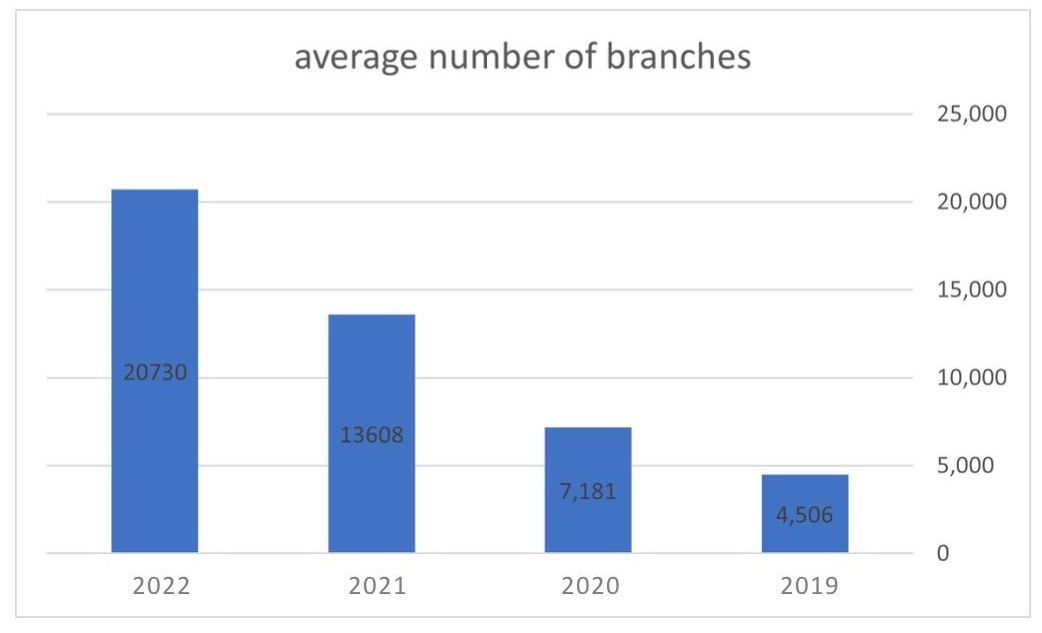
Through this large and diverse geographical spread, you can reach a diverse customer base and benefit from a wide network of stores. If the sector continues to grow in this way, it will expand regionally as well.
Activities services and market share:
Jahez is a well-known food delivery service that excels at sending out online restaurant orders. In 2016, the company began operations in the city of Riyadh, and in 2017, it began operating in additional cities, and plans to use an expansion strategy to increase its influence in the Gulf Cooperation Council and start operating in Kuwait and Bahrain. It opened its first site in 2020 after purchasing a 60% stake in "co kitchen." The same year, it rapidly expanded into 28 cities before introducing "Pik" in a soft launch in 2021. With a market share of 30% in 2021, up from 13% in 2019, the company is one of the top competitors in its sector.
- Jahez platform: The center of the group's activities, and its technology acts as a source of orders for retailers while also offering full logistical assistance and payment collection procedures. Through a user-friendly mobile application, it seeks to connect retailers, customers, and delivery partners by offering an almost totally automated, rapid, and smooth delivery experience. The business has launched a prime subscription service where food delivery is dependent on a monthly fee in an effort to increase its market share. The company introduced Jahez market services as part of the Jahez App for delivering groceries in collaboration with local supermarkets.
- Pik: is a "quick commerce" company that promises to link clients with a variety of their preferred brands within a 2-to 3-hour time frame by acting as a platform for merchants within their reach. The company created "Pik" in 2020 to extend its reach beyond meal delivery and enable it to offer clients a variety of retail goods, including clothing, cosmetics, and electronics.
- Blu store: In order to provide online services through the "BLUE store" application, the group founded "Blu store" firm in 2020 as a joint venture with "alhilal club investment company." This company specializes in selling and marketing goods under various brands.
- Logi: was founded in 2021 to serve as a logistics solutions provider for the e-commerce and delivery industries in general. Logi wants to empower regional businesses by lowering operating expenses and become the most dominant force in the kingdom's last-mile delivery. Logi will act as a central hub to support the group's logistical and operational requirements.
- Co kitchens: The company purchased a 60% stake in 2020, and the platform provides restaurant kitchens without eating areas so that food companies can produce food and sell it using a delivery-only business concept. With restaurants increasingly depending on internet food delivery as a way to expand their reach without the additional costs of expensive rent and waiting personnel, cloud kitchens are a characteristic of modern eating trends. It’s expected to increase its market share from 2.5% in 2020 to 8% in 2023.
- Red color: was founded as the company's investment arm in order to further its expansion goals. The firm invests in and targets tech-related industries that make use of the organization's current consumer, vendor, and delivery partner assets.
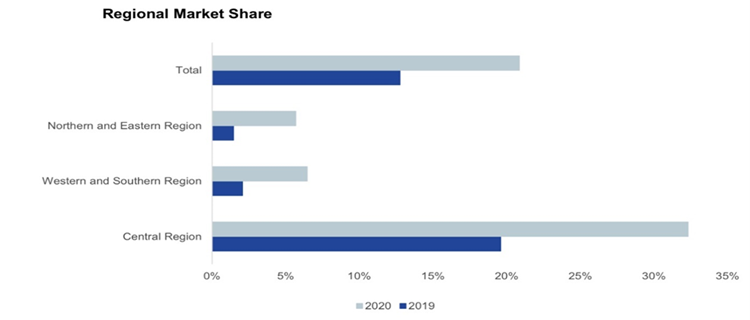
Throughout all regions, Jahez has expanded its market share in the expanding meal delivery industry. From 13% in 2019 to 21% in 2020, and then to 30% in 2021, jahez's market share in the kingdom increased. The business maintained its dominance in the central region in 2020, increasing its market share from 20% to 32%. Additionally, the corporation boosted its market share from 1% in 2019 to 6% in 2020 in the northern and eastern regions, as well as from 2% in 2019 in the western and southern regions.

We have touched on the food delivery sector and the most important developments in it, then we moved to the details of the company and its activities, and now we will present the most important competitors to Jahez in this sector.
Competitors:
Deliveroo, Just Eat, and Delivery Hero which acquired Hungerstation. are all food delivery companies operating in different regions and are considered a strong competitor to Jahez. In recent years, the food delivery industry has experienced significant growth due to the increasing demand for convenience and the popularity of online ordering. As a result, many companies have entered the market, making it highly competitive.
Deliveroo
is a UK-based company that operates in several countries around the world. The company offers food delivery services to customers from a range of restaurants and food outlets, with a market capitalization of around $8.8 billion as of May 2021. Deliveroo's business model involves partnering with restaurants to offer their menu items on the platform, which are then delivered to customers by a fleet of independent couriers, it had a 24% share of the food delivery market in the UK in 2020.
Just Eat
is another UK-based company that operates in several countries around the world, including the UK, Canada, and Australia, it has a market capitalization of around $11.6 billion. Like Deliveroo, Just Eat partners with restaurants to offer their menu items on the platform, which are then delivered to customers by independent couriers, it had a 29% share of the food delivery market in the UK in 2020.
Hungerstation
Saudi Arabia is one of the most important markets for Delivery Hero in the Middle East, North Africa and Turkey, a region that was responsible for almost half of its revenue last year. Hunger station was acquired by Hello food (food panda) in August 2016 for a sum of money, later that year, Food panda was transferred to Delivery Hero, and finally the Hello food brand was introduced by Hunger Station in Saudi Arabia.
Hunger station was established in March 2012 in Dammam, as one of the first online food ordering platforms in the Kingdom of Saudi Arabia. Today, Hunger station allows you to order dishes that you like from various restaurants and make sure the food is delivered to where you want it. It simplifies your food selection by bringing together leading restaurants in your city, pairing thousands of restaurants with their customers in the Kingdom of Saudi Arabia & Bahrain.
Hunger station In 2022, it reached revenues of 2.4 billion riyals (a growth rate of 36% compared to the previous year), and a net profit of 183 million riyals (3 times the previous year), in spite of a major rise in the profits of Hunger station, but the net profit margin is less than 7% because companies of this type requires high spending on marketing and technology compared to others, in addition to, shipping expenses. It is also considered Jahez's biggest competitor in the food delivery sector through apps. Analyzes indicated that its marketing share at the beginning of 2021 ranged between 44% and 49%, compared to Jahez, whose marketing share in the same year was estimated at only 28%.
After we talked about the details of the company and its activities and identify its competitors, we will now discuss a comparison between the company and its competitors in financial ratios:
Stability Ratio:
To support a certain level of output, businesses need a certain level of current and fixed assets. An organization's current assets typically rise along with its sales and revenues. Divide the current assets of a company by its fixed assets to get the CA/FA ratio. A lower CA results in an aggressive CA/FA ratio, whereas a higher CA creates a conservative ratio.
There is no doubt that an organization managing a higher level of current assets, or in the case of a conservative ratio, has the best level of liquidity and this leads to having the lowest level of risk. Similar to the previous example, when the CA is lower or when the CA/FA ratio is aggressive, the firm's liquidity is at its lowest level while its risk is at its highest.

As shown above, Jahez managed to have the highest ratio due to having large amounts of cash and liquidity especially in 2020, however in the last few years the ratio is decreasing showing signs of using the cash. Delivery hero is having the lowest compared to other peers.
Deliveroo and Jahez are ahead of the others, Deliveroo’s 4-year average is 5x increasing and reaching the highest point in 2021 reached 9x. While Jahez’s average is 7.3x the highest is in 2020 with 12.5x.
With the food delivery sector, there aren’t any large amounts of fixed assets the changing in assets is generally from changes in cash, this indicate that the ratio is generally most affected by cash.
Solvency Ratio:
To determine the extent to which a company is financing its operations with liabilities rather than its own resources. Liabilities-to-equity ratio is used. Since Jahez doesn’t have any debt, the total liabilities have been taken into calculating the ratio.
It is known the food delivery industry doesn’t rely heavily on debt, by looking at the liabilities to equity ratio it gives a sense how the company is relying on their liabilities.
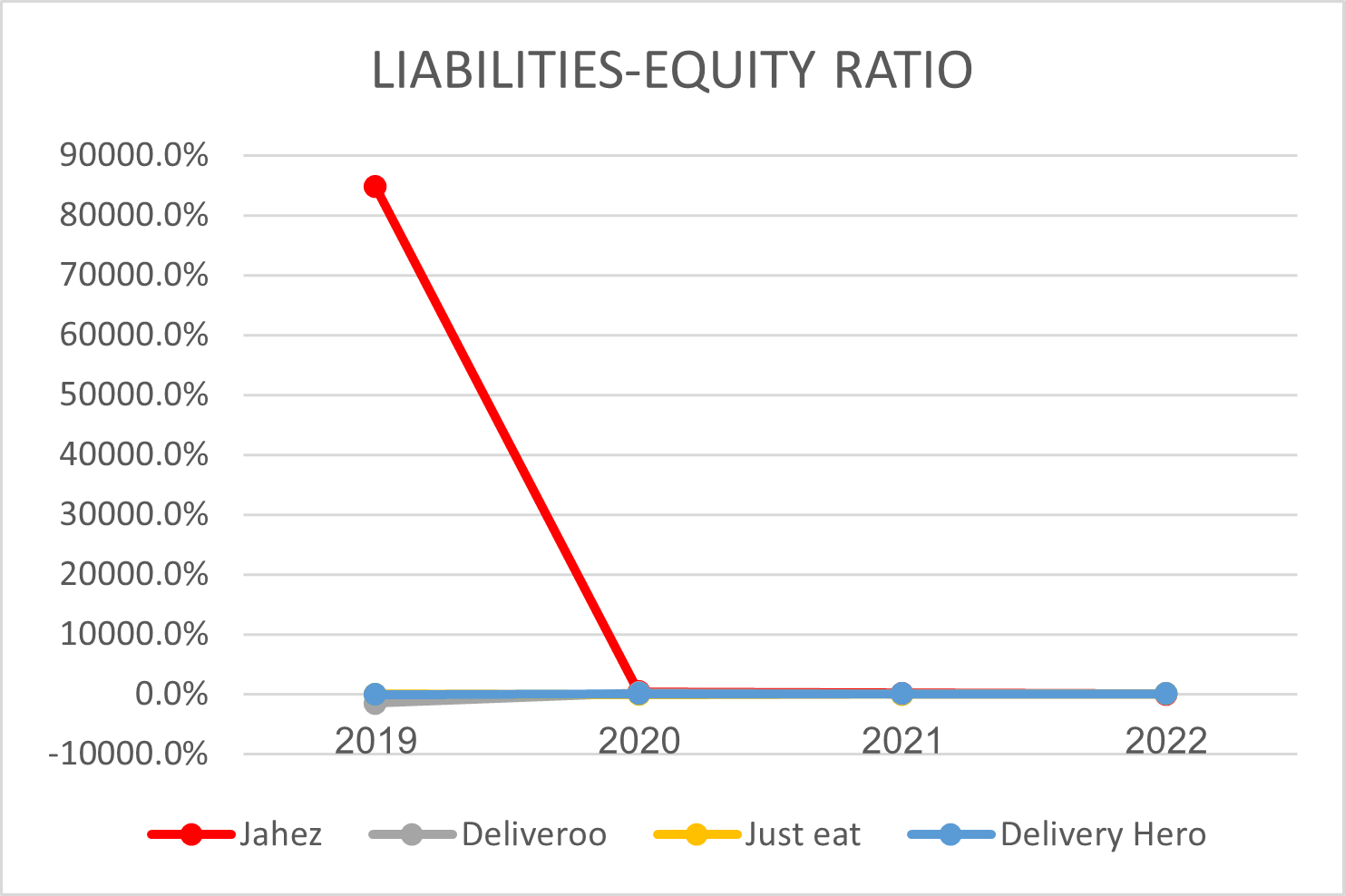
As shown above, in 2019 Jahez was relying heavily on liabilities before the company become public the ratio was at the highest, Deliveroo had a negative total equity in 2019 mainly to having cumulative losses that negatively affected retained earnings leading to the negative equity, the next years have shown improvements in the ratio. Just Eat’s ratio has been stable over the years, the lowest liabilities to equity ratio, the company is focusing on equity, however the past three years the ratio has been increasing to break the 50% and above reaching 56% in 2022.
Just Eat’s equity have been decreasing due to having negative net income, and the past two years the debt increased leading to the increase in the liabilities, however, even though debt and total liabilities are increasing Just Eat has the most stable ratio among the peers.
Delivery Hero’s ratio has been increasing over the past years, in 2019 the ratio was 33% and reached in 2022 to 113%, the losses in net income negatively affected the equity, and the liabilities have been increasing.
Jahez is a profitable company unlike global peers who are making losses, mainly due the higher intense competition meaning higher S&M expenses this surely will pressure them to focus on their bottom line so might lose an edge on the competition. On the other hand, Jahez’s ratio is showing improvements in 2022 it decreased to reach the lowest at 40.5% by comparing to the year 2020 being 410%. The improvements are due to the increase in and focus on equity.
Return on equity ratio (ROE):
Return on Equity (ROE) indicates a company's profitability. By measuring how much shareholders gain from their investment in the company, and sometimes used to estimate how successful the company's management is at making a profit from the assets it owns. It is calculated by dividing the net income by the shareholders’ equity.

The return on equity ratio of Jahez Company from 2019 was negative, as the company’s net income achieved a loss due to the increase in costs, the most prominent of which was advertising costs. As for the year 2020, we notice an increase in the percentage due to the high increase in revenues that came during the period of closing the food service inside the restaurant during the Corona crisis, as the Jahez application provided new services to deal with the crisis, and food delivery and other retail products were added, which increased the number of Delivery requests reached 19.5 million requests during 2020, while in 2019 it was only 7 million requests. After that, the percentage began to decrease. The most important reason may be the increase in costs. In 2022, administrative expenses increased significantly, as they included salaries and benefits for drivers. This was to complete the procedures The crisis for drivers to join the operational team.
We can observe the negative ratios of global competitors, as the net income of most competitors during the past four years recorded a loss. Due to the high operational costs year after year, the most important of these costs were advertising costs (marketing) and the costs of salaries of workers, maybe the reason for the increase in salaries to keep pace with the increasing demand for the services provided.
Current Ratio:
This ratio shows the degree to which current assets cover current liabilities and therefore measures financial balance, i.e., achieving consistency between short-term uses and short-term financial assets, in other words, the entity has the financial capacity to meet short-term financial obligations.

The highest percentage of Jahez's share was in 2022, as the company invested in term deposits (Murabaha) at a rate of return (from 3% to 6%), which increased current assets, which means that Jahez has the ability to pay its short-term obligations. After Jahez, Deliveroo came in with 374% in 2021, followed by Delivery Hero with 334% in 2020. Then Just Eat with the lowest rate of 56.3% in 2019.
The reason for the high liquidity ratio of Jahez and its competitors is that the current assets have always been higher than the current liabilities.
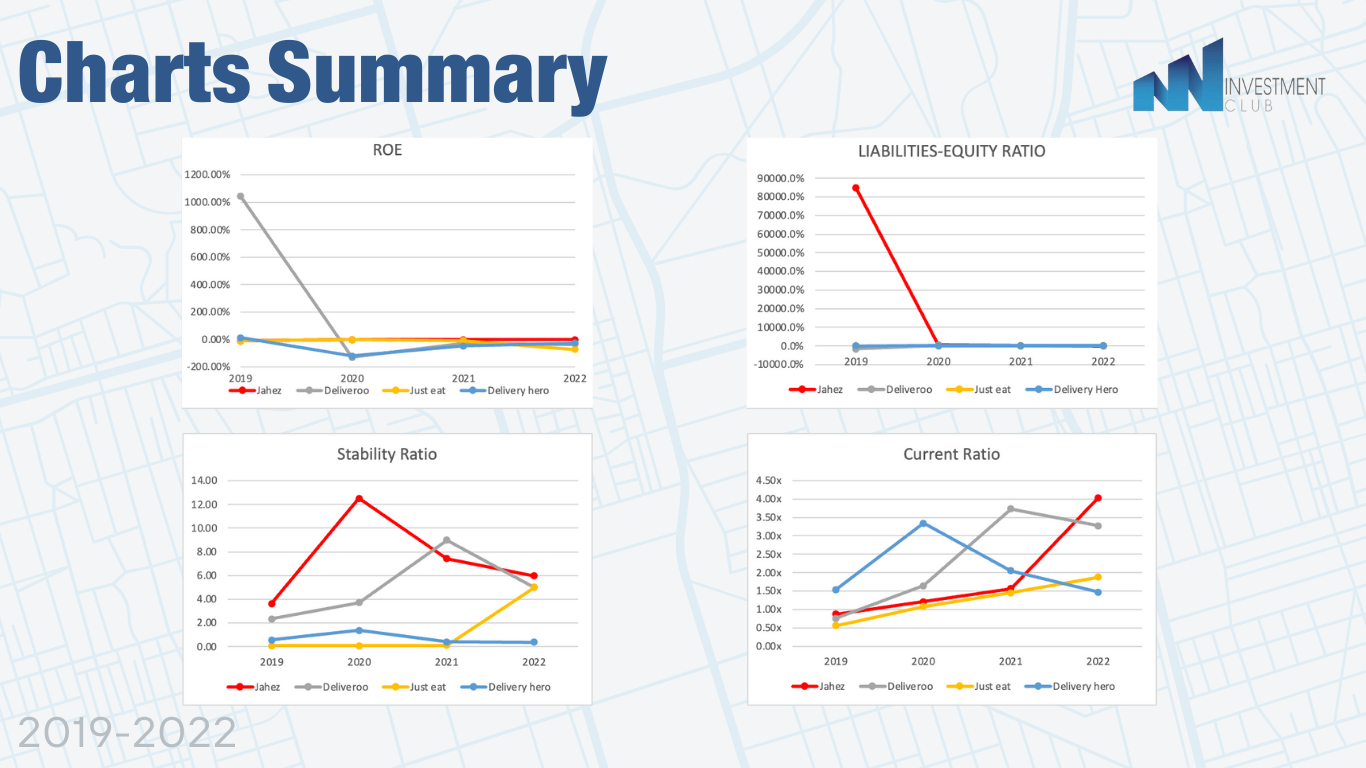
Resource:
- https://www.wallstreetmojo.com/financial-ratios/
- https://finance.yahoo.com/quote/DHER.DE?p=DHER.DE&.tsrc=fin-srch
- https://finance.yahoo.com/quote/TKWY.AS?p=TKWY.AS&.tsrc=fin-srch
- https://finance.yahoo.com/quote/ROO.L?p=ROO.L&.tsrc=fin-srch
- https://ir.deliveryhero.com/financial-reports-and-presentations/
- https://www.grandviewresearch.com/industry-analysis/online-food-delivery-market-report
- https://www.innoviusresearch.com/blog/market-report/saudi-arabia-online-food-delivery-market/
- https://jahezgroup.com/wp-content/uploads/2021/12/Jahezen.pdf
- https://twitter.com/waleed_albarrak/status/1651921969376264192
- https://thmanyah.com/24124/#
- https://www.almrsal.com/post/962704
- https://www.saudiexchange.sa/Resources/fsPdf/2663_0_2022-01-04_14-22-25_Ar.pdf
- https://www.saudiexchange.sa/Resources/fsPdf/2663_0_2023-03-22_15-27-57_Ar.pdf
- file:///C:/Users/Hind%20Saud/Downloads/DeliveryHero_Financial_Statements_2020_en.pdf
- https://s3.eu-central-1.amazonaws.com/takeaway-corporatewebsite-dev/JET-JV2021-080322.pdf
- https://spu.edu.sy/downloads/files/1537361830_Finacial%20analysisSPU.pdf
- file:///C:/Users/Hind%20Saud/Downloads/%D8%A7%D9%84%D8%AA%D9%82%D8%B1%D9%8A%D8%B1%20%D8%A7%D9%84%D8%B3%D9%86%D9%88%D9%8A%202022%20(2).pdf
- file:///C:/Users/Hind%20Saud/Downloads/%D8%A7%D9%84%D8%AA%D9%82%D8%B1%D9%8A%D8%B1%20%D8%A7%D9%84%D8%B3%D9%86%D9%88%D9%8A%202021%20(2).pdf
Prepared by:
Raghad Alghamdy
Sadeem Almegbel
Hind Alanazi
Reema AlNami
Ream Alsahli
Shatha Alzahrani